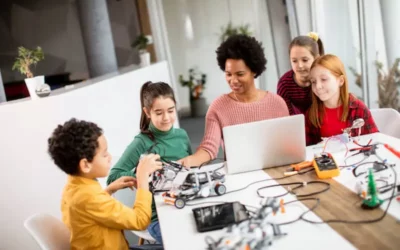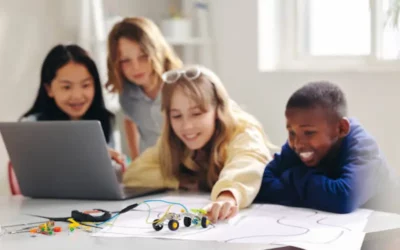Robotics for kids is an engaging gateway to STEM education, emphasizing the importance of hands-on learning. With LEGO robotics kits, children not only delve into the exciting realm of building and coding but also acquire essential problem-solving and critical-thinking skills in a fun and educational setting. Hands-on learning in STEM education, especially in robotics for kids, sparks curiosity and nurtures a practical understanding of scientific and technological concepts. LEGO robotics kits offer an interactive platform, encouraging creativity and teamwork while instilling a passion for learning in young minds.
In this blog, discover how LEGO Robotics Kits for Kids seamlessly blend play and education, offering a captivating journey into the world of robotics. These kits empower children to build, code, and innovate, fostering essential STEM skills in an engaging and imaginative way.
Table of contents
- The Benefits of LEGO Robotics for Kids
- Choosing the Right LEGO Robotics Kit
- LEGO Mindstorms vs. LEGO Boost
- Getting Started: Setting Up Your LEGO Robotics Kit
- Basic Programming Concepts for Kids
- Fun and Educational Projects for Beginners
- Advanced Projects to Challenge Young Engineers
- Troubleshooting Tips for Common Issues
- Inspiring Creativity: Showcasing LEGO Robotics Creations
- Conclusion
- Frequently Asked Questions ( FAQs )
The Benefits of LEGO Robotics for Kids
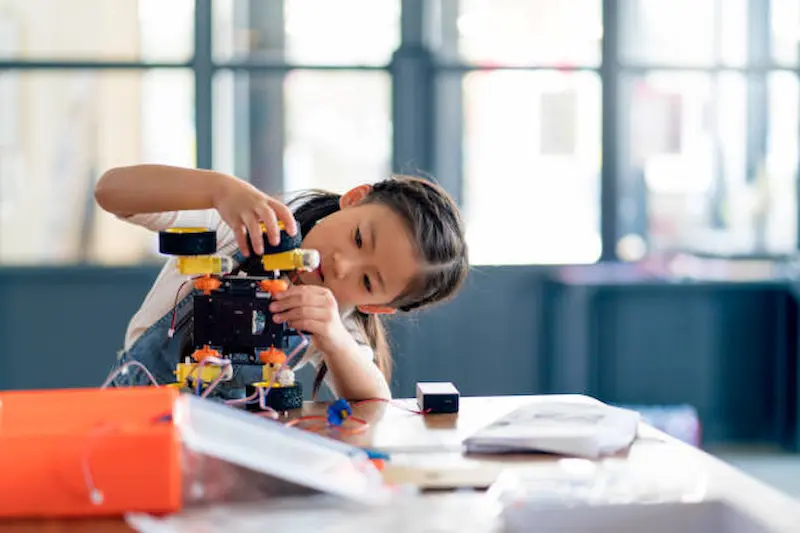
A. Development of critical thinking skills:
LEGO Robotics engages children in hands-on problem-solving, promoting the development of critical thinking skills for kids. As they construct and program robots, kids learn to analyze challenges, identify solutions, and refine their approaches.
B. Enhancing problem-solving abilities:
Through trial and error in constructing robots, children cultivate effective problem-solving skills.
LEGO Robotics provides a dynamic platform for kids to encounter and overcome challenges, fostering resilience and adaptability.
C. Fostering creativity and imagination:
Building with LEGO bricks encourages creativity and imaginative thinking. Kids design and customize robots, unleashing their artistic expression while exploring the endless possibilities within the constraints of the bricks.
D. Building teamwork and collaboration:
LEGO Robotics projects often involve group activities, nurturing teamwork and collaboration. Children learn to communicate, share ideas, and work collectively to achieve common goals, laying a foundation for successful collaboration in future endeavours.
Choosing the Right LEGO Robotics Kit
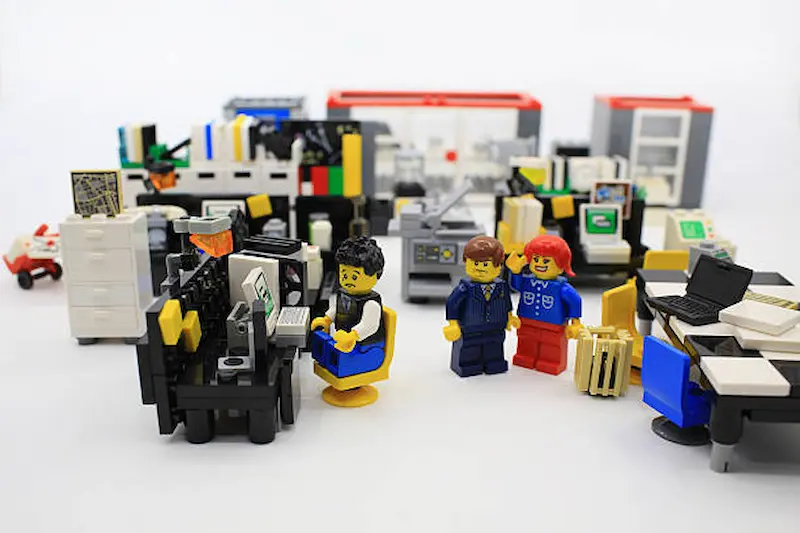
A. Selecting age-appropriate LEGO Robotics kits for kids is crucial for nurturing skills at different developmental stages. Tailor the complexity of the kit to the child’s skill level, ensuring a challenging yet enjoyable learning experience.
B. Deliberate on educational objectives when choosing a LEGO Robotics kit.
Identify specific learning goals, such as enhancing problem-solving or introducing programming concepts, to align the kit with educational outcomes and maximize its impact on skill development.
C. Leverage insights from educators and parents through reviews and recommendations. Understanding real-world experiences with the kits helps make informed decisions, ensuring that the chosen LEGO Robotics kit is not only engaging but also effective in fostering educational growth.
LEGO Mindstorms vs. LEGO Boost
| A. In-depth comparison | B. Features and capabilities | C. Best suited for different age groups | |
| LEGO Mind-storms | Mindstorms offers advanced programming and customization options, making it suitable for older kids and teens interested in robotics and coding. It includes a programmable brick, sensors, and versatile building elements. | Mindstorms boasts sophisticated features like motorised components, sensors for detecting colour and distance, and compatibility with third-party sensors. This kit is designed for complex robotic creations and intricate programming. | Best suited for ages 10 and above, particularly those with a keen interest in coding, engineering, and advanced robotics. |
| LEGO Boost | Boost is geared towards younger builders, providing a simpler introduction to robotics. It features a more straightforward coding interface and focuses on creative play. | Boost includes a motorised hub, sensors, and an array of bricks for building different models. The coding is more visual, making it accessible for beginners. | Ideal for ages 7-12, Boost is suitable for kids who are new to robotics and want a hands-on, creative introduction to programming and building. |
Getting Started: Setting Up Your LEGO Robotics Kit
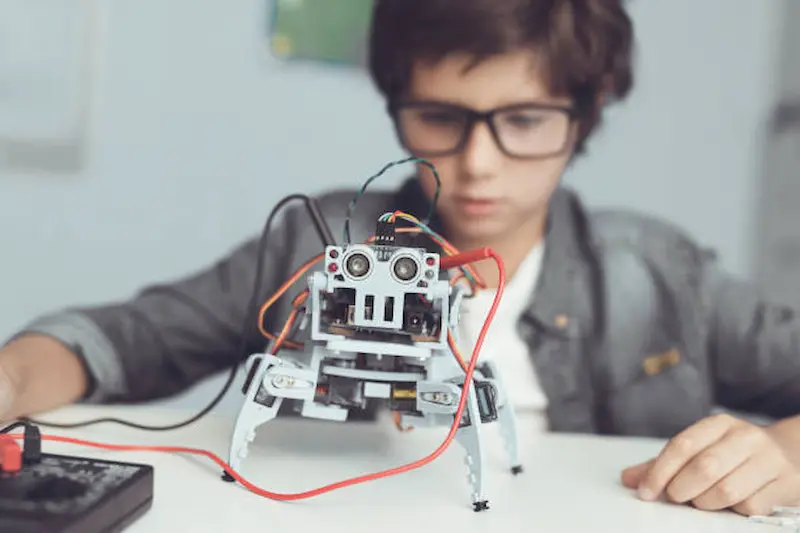
A. Begin your LEGO Robotics journey by unboxing and assembling the components. Familiarise yourself with the diverse pieces, ensuring a clear understanding of the building blocks for your robotic creation.
B. Introduce the main components and their functions to establish a foundational knowledge of the robotics kit designed for kids in our engaging robotics classes for kids.
Explore the exciting world of robotics as you learn about the purpose of sensors, motors, and control units, laying the groundwork for constructing and programming your robot.
C. Seamlessly connect your LEGO Robotics kit to devices and software. Understand the interface between the physical components and the programming environment, enabling a smooth transition from assembly to the exciting phase of coding and experimentation.
Basic Programming Concepts for Kids

A. Initiate young minds into the world of programming language through LEGO robotics and programming for kids, fostering a hands-on approach to coding. Introduce the basics of programming syntax and logic, laying a foundation for computational thinking.
B. Facilitate learning with simple coding exercises tailored for beginners. These exercises not only demystify programming concepts but also empower kids to command their LEGO creations, instilling confidence in their ability to control and customise robotic behaviours.
C. Emphasise the importance of step-by-step programming, teaching kids the value of sequencing in code. This fundamental skill enhances problem-solving capabilities and sets the stage for more complex programming challenges in the future.
Fun and Educational Projects for Beginners

A. Engage budding engineers by building a basic robot model, offering a hands-on introduction to robotics. Utilise readily available materials to construct a simple yet functional robot, emphasising foundational principles of design and assembly.
B. Ignite curiosity through programming and robotics projects for kids, introducing beginners to the world of coding by instructing the robot to perform simple tasks.
This hands-on and engaging approach allows children to apply programming concepts in real-world scenarios, instilling a fundamental understanding of command execution and control
C. Reinforce learning with hands-on activities, integrating play and education. These interactive experiences solidify concepts, making the educational journey enjoyable and memorable for novice engineers.
Advanced Projects to Challenge Young Engineers

A. Embark on the journey of creating a custom robot design, encouraging innovation and problem-solving. Explore various materials, shapes, and mechanisms to build a unique robotic companion.
B. Elevate engineering skills with the best robotics for kids by incorporating sensors and motors into your robot for enhanced functionality. Dive into the intricacies of how these cutting-edge components interact to enable precise movements, object detection, and environmental responsiveness.
C. Delve into the realm of programming by crafting complex sequences and commands. Develop the ability to code intricate behaviours, paving the way for autonomous decision-making and adaptability in diverse scenarios. These projects not only hone technical expertise but also foster creativity, preparing young engineers for the future of robotics.
Troubleshooting Tips for Common Issues

A. Navigate programming challenges with expertise by delving into debugging techniques. Understand and address basic programming errors to ensure the seamless execution of your robotic projects.
B. Tackle technical glitches related to hardware components with confidence while teaching kids patience.
Learn effective strategies to identify and resolve issues with sensors, motors, and other critical elements, enhancing the overall functionality and performance of your robotic creations.
C. Access additional support and troubleshooting resources to expand your knowledge base. Whether through online forums, community groups, or educational materials, leveraging these resources equips you with the tools needed to overcome hurdles and master the art of troubleshooting in LEGO robotics.
Inspiring Creativity: Showcasing LEGO Robotics Creations

Exhibiting LEGO Robotics creations serves as a catalyst for inspiration, highlighting the fusion of technology and imagination. These showcases not only demonstrate technical prowess but also inspire future innovators, fostering leadership skills for kids. By featuring a spectrum of inventive designs and problem-solving solutions, these displays ignite a passion for creativity in young minds, emphasizing that LEGO Robotics is a dynamic medium for exploration, innovation, and limitless possibilities in the realms of science, technology, engineering, and art.
Conclusion
LEGO Robotics Kits for kids are educational tools that combine building blocks with technology, fostering hands-on learning in programming and engineering. These kits not only cultivate creativity and problem-solving skills but also provide a fun and interactive way for children to explore the principles of robotics and STEM concepts.
To get your hands on more such articles, educational content, and free resources on coding for kids, robotics courses, game development, etc., check out the BrightCHAMPS Blog Page now!
Frequently Asked Questions ( FAQs )
A1. The ideal age to start with LEGO robotics is around 7-12 years, with Boost being suitable for beginners and Mindstorms for older kids and teens interested in advanced robotics.
Q2. How do LEGO Mindstorms and LEGO Boost differ?
A2. LEGO Mindstorms is geared towards older kids and offers advanced programming and customization, while LEGO Boost is designed for younger builders, providing a simpler introduction to robotics.
Q3. Can girls enjoy and benefit from LEGO robotics?
A3. Yes, girls can thoroughly enjoy and benefit from LEGO robotics, fostering creativity, problem-solving skills, and a passion for STEM fields.
Q4. Are there online resources for additional projects and challenges?
A4. Yes, there are various online resources offering additional LEGO robotics projects and challenges, expanding the learning experience beyond the kits.
Q5. How much parental involvement is required?
A5. Parental involvement varies, but a moderate level is beneficial, especially for younger children, to provide guidance and encouragement.
Q6. What skills can kids develop through LEGO robotics?
A6. Kids can develop critical thinking, problem-solving, creativity, and teamwork skills through LEGO robotics.


 We are an army of educators and passionate learners from BrightChamps family, committed to providing free learning resources to kids, parents & students.
We are an army of educators and passionate learners from BrightChamps family, committed to providing free learning resources to kids, parents & students.




